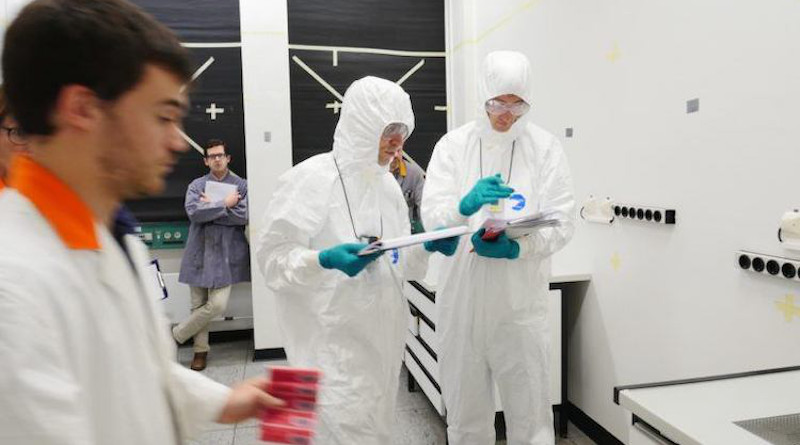Towards Nuclear Disarmament With Monitoring And Verification
By IDN
By Radwan Jakeem
With the international community persistently striving for a world free of nuclear weapons, verification systems and methods are crucial to understanding the complex challenges of accurately monitoring and verifying future nuclear disarmament activities which will likely subject countries to more intrusive verification than ever before.
Learning from verification experience gained by the U.S. and Russia and dialogues at the International Partnership for Nuclear Disarmament Verification (IPNDV), the five permanent members of the UN Security Council – USA, Russia, Britain, France and China – in particular and interested States in general can contribute to an effective nuclear weapons ban as envisaged by the Treaty on the Prohibition of Nuclear Weapons (TPNW).
IPNDV, which started five years ago with the participation of more than 25 countries is a public-private initiative of the U.S. State Department with the Nuclear Threat Initiative (NTI) designed to build capacity among both states with and without nuclear weapons, and develop technical solutions for monitoring and verification challenges.
Over the past three decades, the number of nuclear weapons has decreased considerably – reportedly to about 14,500 – from the peak arsenals of the Cold War. Key to these dramatic reductions, according to disarmament experts, has been the ability of countries to verify each other’s compliance with implementing the arms control treaties.
In order to lay a solid foundation for further reductions in nuclear weapons and advance nuclear disarmament goals enshrined in the Treaty on the Non-Proliferation of Nuclear Weapons (NPT), an accurate assessment of monitoring and verification issues across the nuclear weapons lifecycle is of vital importance – from production of fissile material and warheads, warhead inventories, the dismantlement of nuclear weapons, and the disposition of nuclear material resulting from the dismantlement process.
Article VI of the NPT urges each of the Parties to the Treaty to undertake “to pursue negotiations in good faith on effective measures relating to cessation of the nuclear arms race at an early date and to nuclear disarmament, and on a treaty on general and complete disarmament under strict and effective international control”.
The IPNDV established technical working groups in Phase I and Phase II to steer and facilitate its work. During the first multi-year phase (2015-2017), experts in these groups laid significant groundwork in identifying potential procedures and technologies that can be used across the 14 steps in the nuclear dismantlement “lifecycle”.
The work resulted in more than 35 detailed reports and papers published on the IPNDV website. Moving forward into Phase II of the Partnership, the three working groups made plans to take their work from “paper to practice” by preparing hands-on activities, such as exercises and technology demonstrations.
These activities included an exercise on verification of non-diversion of materials around a simulated nuclear warhead dismantlement called “NuDiVe”, led by Germany and France, and a Belgian-led demonstration assessing technology methods to detect the presence or absence of nuclear material. Both activities included participants from several of the 25+ IPNDV partner countries.
The seventh International Partnership for Nuclear Disarmament Verification plenary meeting brought 89 representatives from 24 countries, plus the European Union, to Ottawa, Canada from December 3-5, 2019 to complete Phase II and to begin planning for Phase III.
The meeting included presentations about practical exercises and technical demonstrations that took the Partnership’s findings “from paper to practice”. Partners focused on technical gaps and policy questions that they were scheduled to address in Phase III which will officially kick-off in March 2020 when the government of Switzerland will host a symposium on March 18-19 in Geneva, highlighting the work of the IPNDV and its place in the broader context of nuclear disarmament verification. The symposium will feature panel discussions, an interactive exhibition that showcases the work of the IPNDV, and a poster session that highlights on-going research in the field of nuclear disarmament verification.
The symposium and exhibition—to be held just a few weeks before the the Non-Proliferation of Nuclear Weapons (NPT) Review Conference from April 27-May 22 at UN Headquarters in New York —will highlight: the work of IPNDV during the first two Phases of the Partnership’s work; the potential role, and limits of technology in nuclear disarmament verification; the utility of practical disarmament verification exercises and demonstrations; and the IPNDV’s work in the broader context of nuclear disarmament. The poster session will feature work on scientific, technology, and procedural issues related to nuclear disarmament verification.
The IPNDV’s Phase II Summary Report: Moving from Paper to Practice in Nuclear Disarmament Verification, released in January 2020, addressed verification of nuclear weapon declarations, verification of reductions, and technologies for verification.
After the plenary meeting, IPNDV participants visited the Canadian Nuclear Laboratories’ Chalk River Site, the historical home to Canada’s first nuclear reactor. Participants observed demonstrations of experimental techniques for verifying the presence or absence of weapons-grade nuclear materials. These are important tasks for the nuclear disarmament verification process.
The Chalk River demonstration was one of five practical exercises and technology demonstrations conducted during Phase II to advance the Partnership’s ability to identify technologies and procedures that could be applied across all stages of the nuclear weapons dismantlement lifecycle.
In addition to the exercises and demonstrations, Phase II explored how to characterize other monitoring and verification considerations such as state declarations and treaty limitations.
These activities ultimately reinforced the findings of Phase I that multilateral verification of nuclear dismantlement is possible, although it will be challenging and will require a tailored application of verification options—tools, policies, and procedures—to prevent disclosure of proliferation-sensitive safety and security as well as external factors unique to a given country’s nuclear weapons enterprise.

